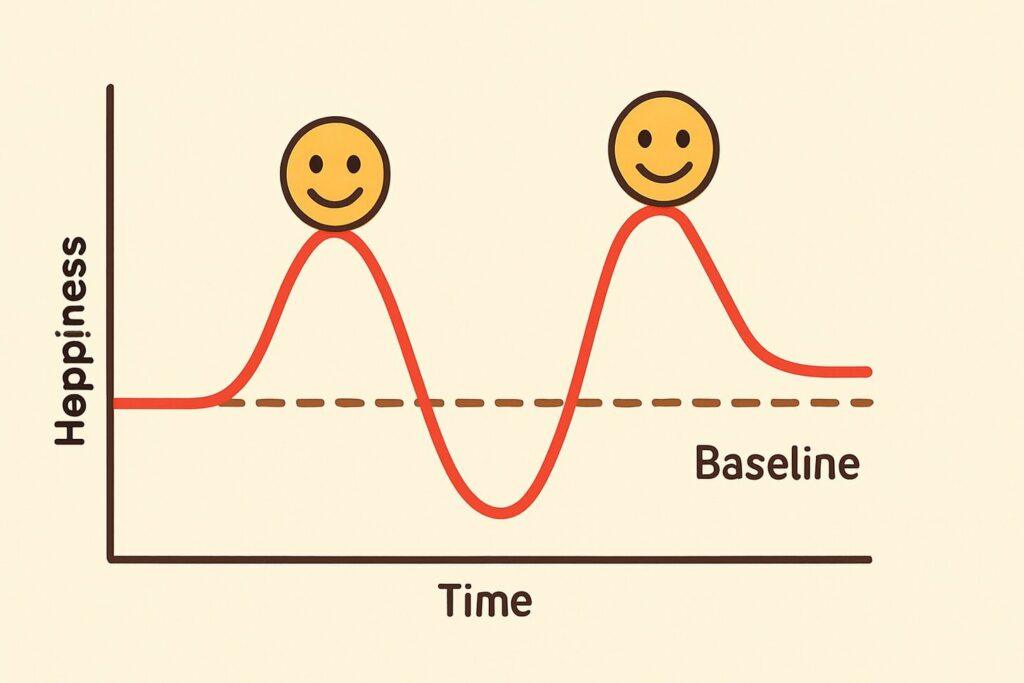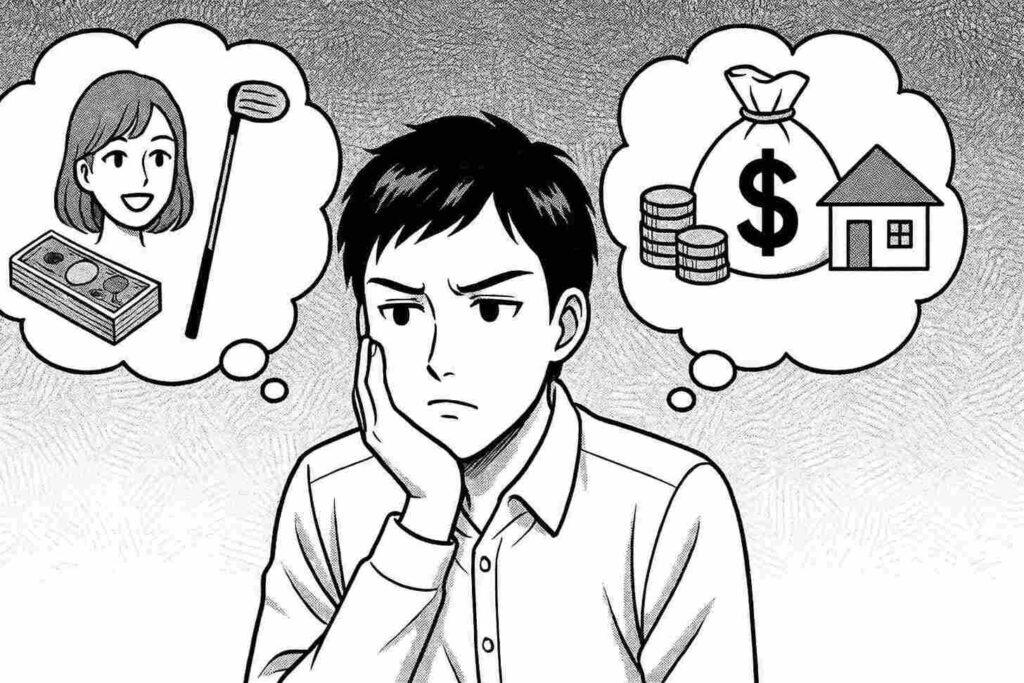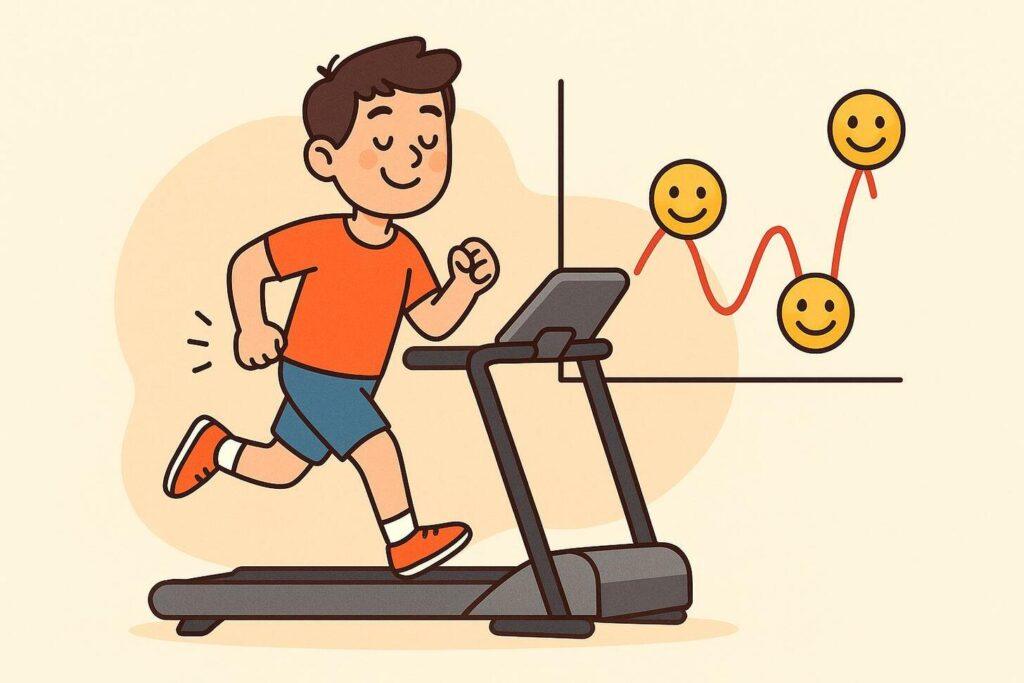This model shows why big life changes, like more money or success, don’t bring lasting joy. Knowing this, you can make better choices and set goals that truly matter. You can build a life that brings lasting happiness and well-being.
In this article, we’ll explore why humans struggle to maintain lasting happiness despite achievements, how this mental model affects your decision-making, and most importantly, research-backed strategies to step off the treadmill and cultivate more enduring well-being.
What Is the Hedonic Treadmill Mental Model?
The hedonic treadmill represents our tendency to return to a baseline level of happiness despite positive or negative life events
The hedonic treadmill, also known as hedonic adaptation, is the observed tendency of humans to quickly return to a relatively stable level of happiness despite major positive or negative events in their lives. This psychological phenomenon suggests that our emotional response to life changes—whether winning the lottery or experiencing a serious setback—tends to diminish over time as we adapt to new circumstances.
Psychologists explain that this adaptation serves an evolutionary purpose. Our brains are wired to notice changes in our environment rather than constants. This helped our ancestors stay alert to potential threats and opportunities. However, in modern life, this same mechanism can leave us in a perpetual pursuit of the next achievement, possession, or experience that might bring happiness—hence the treadmill metaphor.
“Whatever we have, we tend to get used to it. So no matter how awesome our lives might be, or what wonderful things come into our lives, we tend to get used to them over time, and the pleasure that they provide gradually diminishes.”
Research indicates that as much as 50 percent of your capacity for happiness may be genetically determined. This creates what psychologists call a “happiness set point”—a baseline level of subjective well-being that remains relatively constant throughout life, regardless of changing circumstances.
How the Hedonic Treadmill Functions as a Mental Model
As a mental model, the hedonic treadmill provides a framework for understanding how people make decisions, set goals, and evaluate their sense of satisfaction. Here’s how it influences our way of thinking and the effects it has on our lives:

Happiness spikes after achievements but typically returns to our personal baseline over time-the headonic treadmill mental model
Prediction Errors
We consistently overestimate how happy future achievements will make us and how long that happiness will last. This leads to what economists call “miswanting”—pursuing goals that won’t deliver the sustained satisfaction we expect.
Consumption Patterns
The hedonic treadmill drives consumer behavior. We purchase items expecting lasting happiness, only to find the joy fades, prompting us to buy more. Marketers understand and leverage this psychological tendency.
Goal Setting
After achieving a goal, we quickly adapt and set new, often more ambitious goals. This can be motivating but may also lead to a never-ending pursuit where we’re never satisfied with our accomplishments.
Comparative Thinking
We evaluate our happiness not in absolute terms but relative to others and our own past. As our circumstances improve, our reference points shift, maintaining a gap between what we have and what we desire.
Understanding the hedonic treadmill as a mental model allows us to recognize these patterns in our thinking and make more informed decisions about what will truly bring lasting satisfaction.
Research-Backed Examples of Hedonic Adaptation
Numerous studies have documented the hedonic treadmill effect across various life domains. Here are some of the most compelling examples:
The Lottery Winner Study
In a classic study, researchers compared lottery winners with accident victims who had become paralyzed. Initially, lottery winners reported higher happiness levels, while accident victims reported lower levels. However, after some time, both groups largely returned to their pre-event happiness baselines.
This research demonstrated that even extreme positive or negative life events don’t permanently alter our happiness levels as much as we might expect.
Income and Happiness Research
Studies have found that while higher incomes correspond with higher levels of well-being, the benefits plateau at around $95,000 annually (according to one study cited by Healthline). Beyond this threshold, additional income produces diminishing returns in happiness.
This research suggests that once basic needs are met, additional wealth doesn’t significantly increase long-term happiness due to hedonic adaptation.
Marriage and Adaptation
Research on marriage shows that newlyweds typically experience a “honeymoon period” of elevated happiness. However, within 1-2 years, most couples adapt to their married state and return to happiness levels similar to their pre-marriage baseline.
This doesn’t mean marriage doesn’t contribute to well-being, but rather that we adapt to even significant positive life changes.
Key Insight: Research indicates that hedonic adaptation occurs more quickly with material possessions than with experiences. Experiences tend to provide more lasting happiness because they become part of our identity and can be positively reinterpreted over time.
Practical Implications of the Hedonic Treadmill
Understanding the hedonic treadmill has significant implications for how we approach various aspects of life:
Personal Finance

Understanding hedonic adaptation can transform your approach to spending and saving
Spending Decisions
Recognizing that material purchases rarely provide lasting happiness can help you make more intentional spending choices. Consider allocating resources toward experiences, relationships, and personal growth, which research suggests provide more durable satisfaction.
Saving Behavior
The hedonic treadmill often drives lifestyle inflation—spending more as you earn more. By understanding this tendency, you can resist upgrading your lifestyle with each raise and instead prioritize financial security and freedom, which provide more sustainable well-being.
Apply This Today
Before your next significant purchase, implement a 72-hour waiting period. Ask yourself: “Will this still bring me joy a month from now? Six months? A year?” This simple practice can help you distinguish between fleeting desires and purchases that align with your values.
Career Goals
Achievement Pursuit
Many professionals chase promotions, titles, and salary increases expecting lasting fulfillment, only to find themselves quickly adapting and wanting more. Understanding this pattern can help you focus on finding meaning in your daily work rather than pinning happiness on future achievements.
Work-Life Balance
The hedonic treadmill can drive workaholism as we continuously pursue the next professional high. Recognizing this tendency allows you to make more balanced choices that prioritize relationships and personal well-being alongside career advancement.
Relationships
Partnership Expectations
In romantic relationships, the initial excitement inevitably fades as partners adapt to each other. Understanding hedonic adaptation can help you appreciate the deeper, more sustainable forms of connection that develop over time rather than chasing the initial “spark.”
Social Connections
Research consistently shows that strong social bonds are among the most reliable predictors of happiness. Unlike material possessions, meaningful relationships tend to provide ongoing satisfaction that resists hedonic adaptation, especially when we continue to invest in them.
Strategies to Step Off the Hedonic Treadmill

Practical strategies to combat hedonic adaptation and cultivate lasting happiness
1. Practice Mindfulness
Mindfulness meditation has been shown to increase the capacity for hedonic happiness, even among people experiencing chronic pain. By training yourself to be present and attentive to current experiences, you can derive more satisfaction from everyday pleasures that might otherwise go unnoticed.
“Mindfulness is associated with increased hedonic capacity among chronic pain patients receiving extended opioid pharmacotherapy.”
2. Express Gratitude
Researchers have found that gratitude—intentionally expressing thanks for positive experiences—is linked to an enlarged capacity for happiness. Regular gratitude practices, such as keeping a gratitude journal or sharing appreciations with others, can help counteract hedonic adaptation by redirecting attention to the good things already present in your life.
3. Savor Experiences
Savoring involves deliberately paying attention to and extending positive experiences. This might include taking mental photographs of special moments, sharing your joy with others, or reminiscing about past positive events. These practices help extract more happiness from experiences before adaptation occurs.
4. Pursue Eudaimonic Happiness
Psychologists distinguish between hedonic happiness (pleasure) and eudaimonic happiness (fulfillment from meaningful activities). Research shows that eudaimonic happiness—derived from personal growth, purpose, and contribution to others—is more resistant to adaptation than pleasure-based happiness.
Hedonic Happiness
- Based on pleasure and enjoyment
- More susceptible to adaptation
- Examples: Good food, entertainment, luxury items
Eudaimonic Happiness
- Based on meaning and purpose
- More resistant to adaptation
- Examples: Personal growth, helping others, creating something meaningful
5. Vary Your Positive Experiences
Adaptation happens more quickly with repetition. By introducing variety into positive experiences—trying new activities, changing routines, or experiencing pleasures in different ways—you can slow the adaptation process and extend the happiness derived from these experiences.
6. Invest in Relationships
Studies from around the world consistently identify strong social connections as a key to sustained happiness. Unlike material possessions, meaningful relationships continue to provide satisfaction over time, especially when we actively nurture them.
Start Your Happiness Practice
Implement one strategy from this article today. Begin with a simple five-minute daily gratitude practice or schedule quality time with a loved one. Small, consistent actions can significantly impact your ability to experience lasting happiness.
Conclusion: Mastering the Hedonic Treadmill Mental Model
Learning the hedonic treadmill mental model helps you find true happiness. It teaches you that more money, titles, or things won’t make you happy. Real happiness comes from meaningful work, strong relationships, and being grateful and mindful.
Behavioral economics and psychology tell us that we adapt easily. But we can control this. By enjoying good moments, building community, and finding purpose, you can stop the treadmill. You can create a life that’s rich and lasting, not just temporary.
When you see something new or a big goal, stop for a moment. Think: Am I chasing real joy, or just running faster on the treadmill?
Key Takeaway: The hedonic treadmill mental model teaches us that lasting happiness comes not from constantly pursuing the next achievement or acquisition, but from appreciating what we have, finding meaning in our activities, and connecting deeply with others.
As you apply these insights to your own life, remember that simple pleasures still matter. As Healthline notes, “Just know that although hedonic pleasures may be fleeting, they’re an important part of your overall well-being.” The goal isn’t to eliminate pleasure-seeking but to balance it with more sustainable sources of happiness.
Apply the Hedonic Treadmill Mental Model
Understanding this concept is just the first step. Real change comes from applying these insights to your daily decisions about career, relationships, and personal growth.
References
Healthline. (2020). What to Know About the Hedonic Treadmill and Your Happiness. Retrieved from https://www.healthline.com/health/hedonic-treadmill
Psychology Today. (n.d.). Hedonic Treadmill. Retrieved from https://www.psychologytoday.com/us/basics/hedonic-treadmill
Waters, B. (2020). Zen and the Art of the Hedonic Treadmill. Psychology Today. Retrieved from https://www.psychologytoday.com/us/blog/design-your-path/202012/zen-and-the-art-the-hedonic-treadmill


